Digital Health Media Analysis: Radio Broadcast, Blogs, and Podcasts
VerifiedAdded on 2022/08/21
|5
|1091
|14
Report
AI Summary
This report critically analyzes three digital health media postings: a radio broadcast on Australian digital health services, a blog post discussing the transformation of healthcare in Australia, and a podcast on antimicrobial use in aged care. The analysis evaluates each posting's support for health education improvement and its contribution to clinical quality and the evidence base. The radio broadcast highlights the benefits of digital health services, such as improved patient care and reduced hospital admissions. The blog post discusses the positive and negative impacts of digitalization on the healthcare system, including the need to address chronic diseases and manage general practitioners. The podcast examines the overuse of antibiotics in aged care and its implications for antibiotic resistance and patient outcomes. Each posting's strengths and weaknesses are discussed, along with its relevance to healthcare professionals and the general public. The report concludes by summarizing the importance of accurate, reliable, and evidence-based digital resources in healthcare.
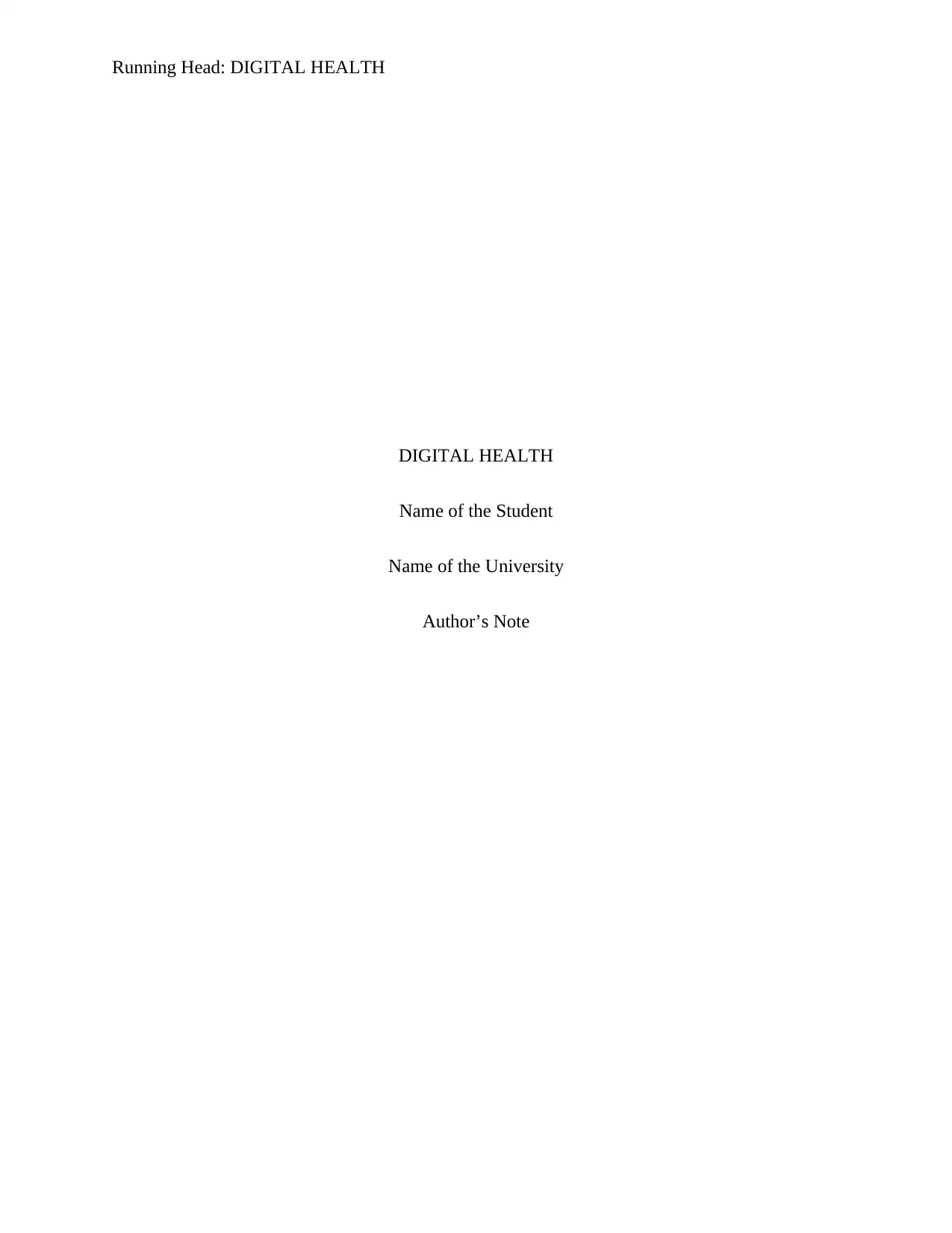
Running Head: DIGITAL HEALTH
DIGITAL HEALTH
Name of the Student
Name of the University
Author’s Note
DIGITAL HEALTH
Name of the Student
Name of the University
Author’s Note
Paraphrase This Document
Need a fresh take? Get an instant paraphrase of this document with our AI Paraphraser
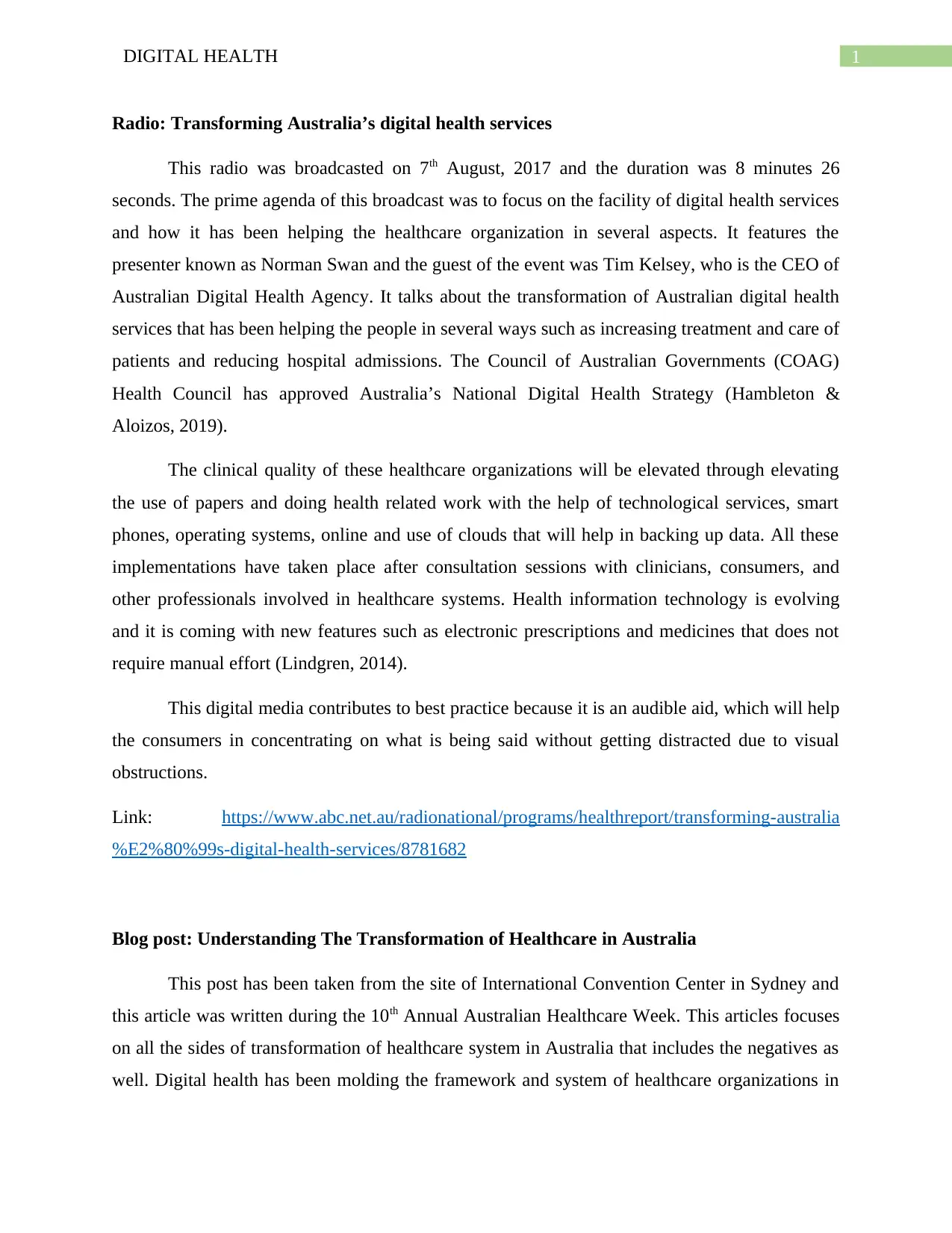
1DIGITAL HEALTH
Radio: Transforming Australia’s digital health services
This radio was broadcasted on 7th August, 2017 and the duration was 8 minutes 26
seconds. The prime agenda of this broadcast was to focus on the facility of digital health services
and how it has been helping the healthcare organization in several aspects. It features the
presenter known as Norman Swan and the guest of the event was Tim Kelsey, who is the CEO of
Australian Digital Health Agency. It talks about the transformation of Australian digital health
services that has been helping the people in several ways such as increasing treatment and care of
patients and reducing hospital admissions. The Council of Australian Governments (COAG)
Health Council has approved Australia’s National Digital Health Strategy (Hambleton &
Aloizos, 2019).
The clinical quality of these healthcare organizations will be elevated through elevating
the use of papers and doing health related work with the help of technological services, smart
phones, operating systems, online and use of clouds that will help in backing up data. All these
implementations have taken place after consultation sessions with clinicians, consumers, and
other professionals involved in healthcare systems. Health information technology is evolving
and it is coming with new features such as electronic prescriptions and medicines that does not
require manual effort (Lindgren, 2014).
This digital media contributes to best practice because it is an audible aid, which will help
the consumers in concentrating on what is being said without getting distracted due to visual
obstructions.
Link: https://www.abc.net.au/radionational/programs/healthreport/transforming-australia
%E2%80%99s-digital-health-services/8781682
Blog post: Understanding The Transformation of Healthcare in Australia
This post has been taken from the site of International Convention Center in Sydney and
this article was written during the 10th Annual Australian Healthcare Week. This articles focuses
on all the sides of transformation of healthcare system in Australia that includes the negatives as
well. Digital health has been molding the framework and system of healthcare organizations in
Radio: Transforming Australia’s digital health services
This radio was broadcasted on 7th August, 2017 and the duration was 8 minutes 26
seconds. The prime agenda of this broadcast was to focus on the facility of digital health services
and how it has been helping the healthcare organization in several aspects. It features the
presenter known as Norman Swan and the guest of the event was Tim Kelsey, who is the CEO of
Australian Digital Health Agency. It talks about the transformation of Australian digital health
services that has been helping the people in several ways such as increasing treatment and care of
patients and reducing hospital admissions. The Council of Australian Governments (COAG)
Health Council has approved Australia’s National Digital Health Strategy (Hambleton &
Aloizos, 2019).
The clinical quality of these healthcare organizations will be elevated through elevating
the use of papers and doing health related work with the help of technological services, smart
phones, operating systems, online and use of clouds that will help in backing up data. All these
implementations have taken place after consultation sessions with clinicians, consumers, and
other professionals involved in healthcare systems. Health information technology is evolving
and it is coming with new features such as electronic prescriptions and medicines that does not
require manual effort (Lindgren, 2014).
This digital media contributes to best practice because it is an audible aid, which will help
the consumers in concentrating on what is being said without getting distracted due to visual
obstructions.
Link: https://www.abc.net.au/radionational/programs/healthreport/transforming-australia
%E2%80%99s-digital-health-services/8781682
Blog post: Understanding The Transformation of Healthcare in Australia
This post has been taken from the site of International Convention Center in Sydney and
this article was written during the 10th Annual Australian Healthcare Week. This articles focuses
on all the sides of transformation of healthcare system in Australia that includes the negatives as
well. Digital health has been molding the framework and system of healthcare organizations in
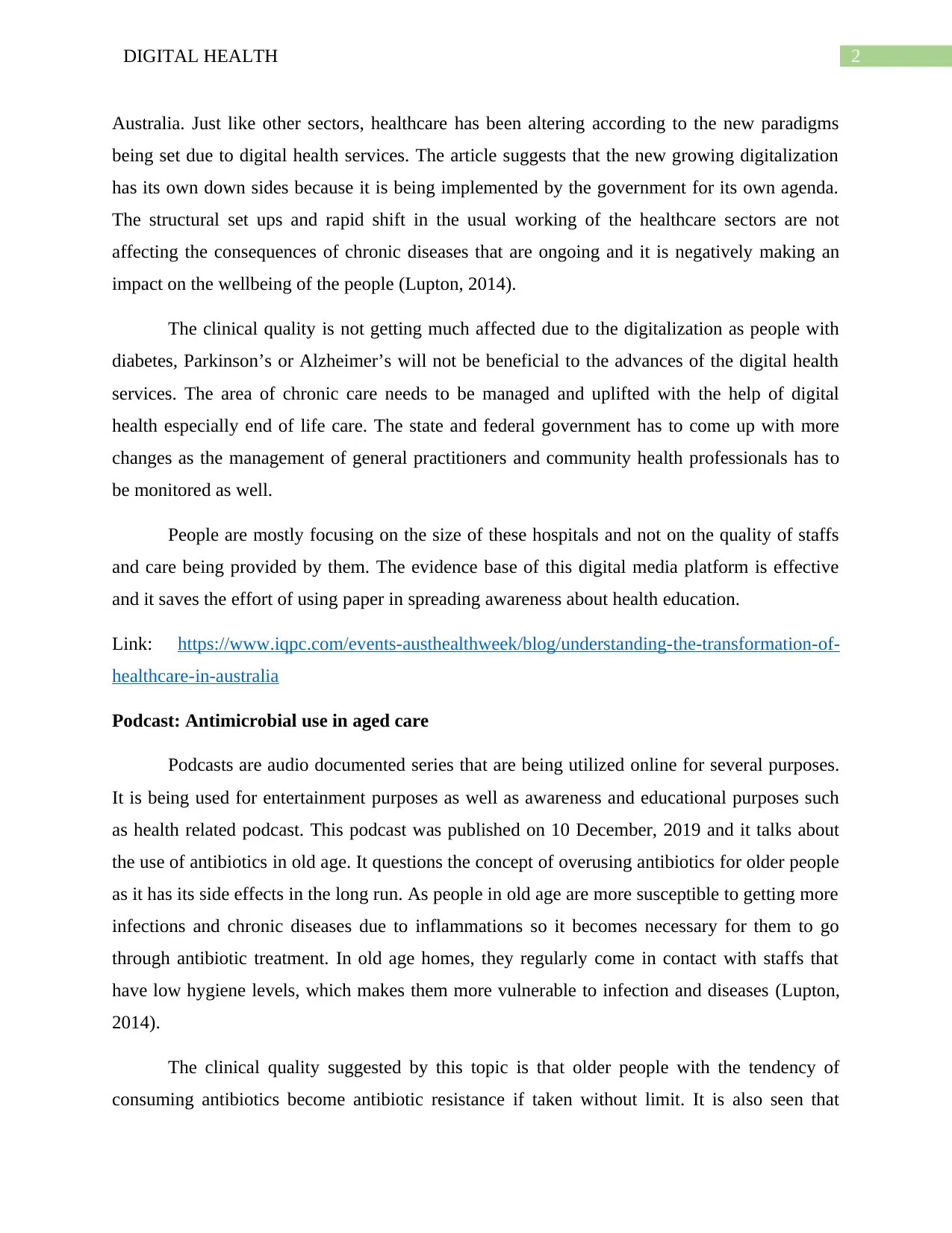
2DIGITAL HEALTH
Australia. Just like other sectors, healthcare has been altering according to the new paradigms
being set due to digital health services. The article suggests that the new growing digitalization
has its own down sides because it is being implemented by the government for its own agenda.
The structural set ups and rapid shift in the usual working of the healthcare sectors are not
affecting the consequences of chronic diseases that are ongoing and it is negatively making an
impact on the wellbeing of the people (Lupton, 2014).
The clinical quality is not getting much affected due to the digitalization as people with
diabetes, Parkinson’s or Alzheimer’s will not be beneficial to the advances of the digital health
services. The area of chronic care needs to be managed and uplifted with the help of digital
health especially end of life care. The state and federal government has to come up with more
changes as the management of general practitioners and community health professionals has to
be monitored as well.
People are mostly focusing on the size of these hospitals and not on the quality of staffs
and care being provided by them. The evidence base of this digital media platform is effective
and it saves the effort of using paper in spreading awareness about health education.
Link: https://www.iqpc.com/events-austhealthweek/blog/understanding-the-transformation-of-
healthcare-in-australia
Podcast: Antimicrobial use in aged care
Podcasts are audio documented series that are being utilized online for several purposes.
It is being used for entertainment purposes as well as awareness and educational purposes such
as health related podcast. This podcast was published on 10 December, 2019 and it talks about
the use of antibiotics in old age. It questions the concept of overusing antibiotics for older people
as it has its side effects in the long run. As people in old age are more susceptible to getting more
infections and chronic diseases due to inflammations so it becomes necessary for them to go
through antibiotic treatment. In old age homes, they regularly come in contact with staffs that
have low hygiene levels, which makes them more vulnerable to infection and diseases (Lupton,
2014).
The clinical quality suggested by this topic is that older people with the tendency of
consuming antibiotics become antibiotic resistance if taken without limit. It is also seen that
Australia. Just like other sectors, healthcare has been altering according to the new paradigms
being set due to digital health services. The article suggests that the new growing digitalization
has its own down sides because it is being implemented by the government for its own agenda.
The structural set ups and rapid shift in the usual working of the healthcare sectors are not
affecting the consequences of chronic diseases that are ongoing and it is negatively making an
impact on the wellbeing of the people (Lupton, 2014).
The clinical quality is not getting much affected due to the digitalization as people with
diabetes, Parkinson’s or Alzheimer’s will not be beneficial to the advances of the digital health
services. The area of chronic care needs to be managed and uplifted with the help of digital
health especially end of life care. The state and federal government has to come up with more
changes as the management of general practitioners and community health professionals has to
be monitored as well.
People are mostly focusing on the size of these hospitals and not on the quality of staffs
and care being provided by them. The evidence base of this digital media platform is effective
and it saves the effort of using paper in spreading awareness about health education.
Link: https://www.iqpc.com/events-austhealthweek/blog/understanding-the-transformation-of-
healthcare-in-australia
Podcast: Antimicrobial use in aged care
Podcasts are audio documented series that are being utilized online for several purposes.
It is being used for entertainment purposes as well as awareness and educational purposes such
as health related podcast. This podcast was published on 10 December, 2019 and it talks about
the use of antibiotics in old age. It questions the concept of overusing antibiotics for older people
as it has its side effects in the long run. As people in old age are more susceptible to getting more
infections and chronic diseases due to inflammations so it becomes necessary for them to go
through antibiotic treatment. In old age homes, they regularly come in contact with staffs that
have low hygiene levels, which makes them more vulnerable to infection and diseases (Lupton,
2014).
The clinical quality suggested by this topic is that older people with the tendency of
consuming antibiotics become antibiotic resistance if taken without limit. It is also seen that
⊘ This is a preview!⊘
Do you want full access?
Subscribe today to unlock all pages.

Trusted by 1+ million students worldwide
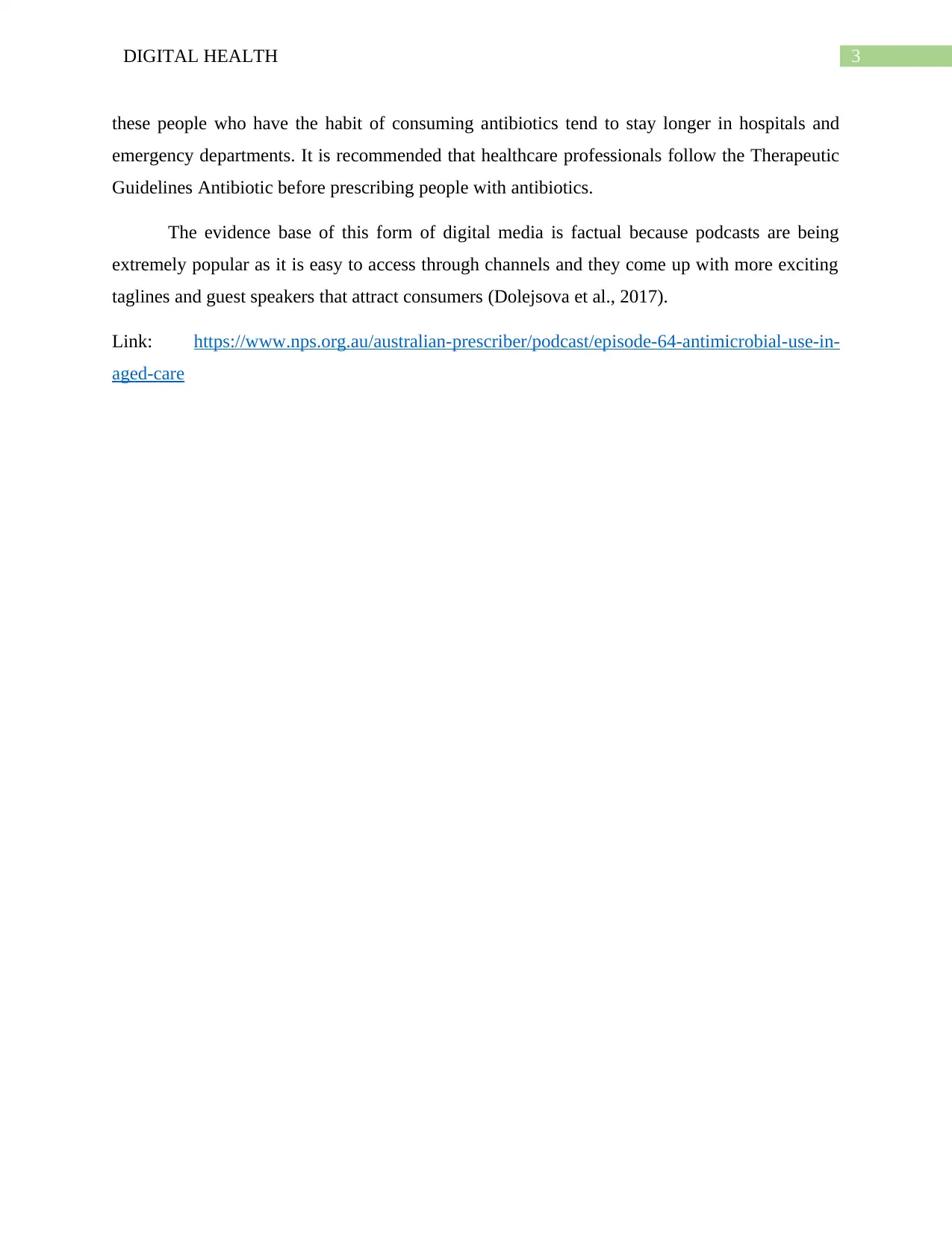
3DIGITAL HEALTH
these people who have the habit of consuming antibiotics tend to stay longer in hospitals and
emergency departments. It is recommended that healthcare professionals follow the Therapeutic
Guidelines Antibiotic before prescribing people with antibiotics.
The evidence base of this form of digital media is factual because podcasts are being
extremely popular as it is easy to access through channels and they come up with more exciting
taglines and guest speakers that attract consumers (Dolejsova et al., 2017).
Link: https://www.nps.org.au/australian-prescriber/podcast/episode-64-antimicrobial-use-in-
aged-care
these people who have the habit of consuming antibiotics tend to stay longer in hospitals and
emergency departments. It is recommended that healthcare professionals follow the Therapeutic
Guidelines Antibiotic before prescribing people with antibiotics.
The evidence base of this form of digital media is factual because podcasts are being
extremely popular as it is easy to access through channels and they come up with more exciting
taglines and guest speakers that attract consumers (Dolejsova et al., 2017).
Link: https://www.nps.org.au/australian-prescriber/podcast/episode-64-antimicrobial-use-in-
aged-care
Paraphrase This Document
Need a fresh take? Get an instant paraphrase of this document with our AI Paraphraser
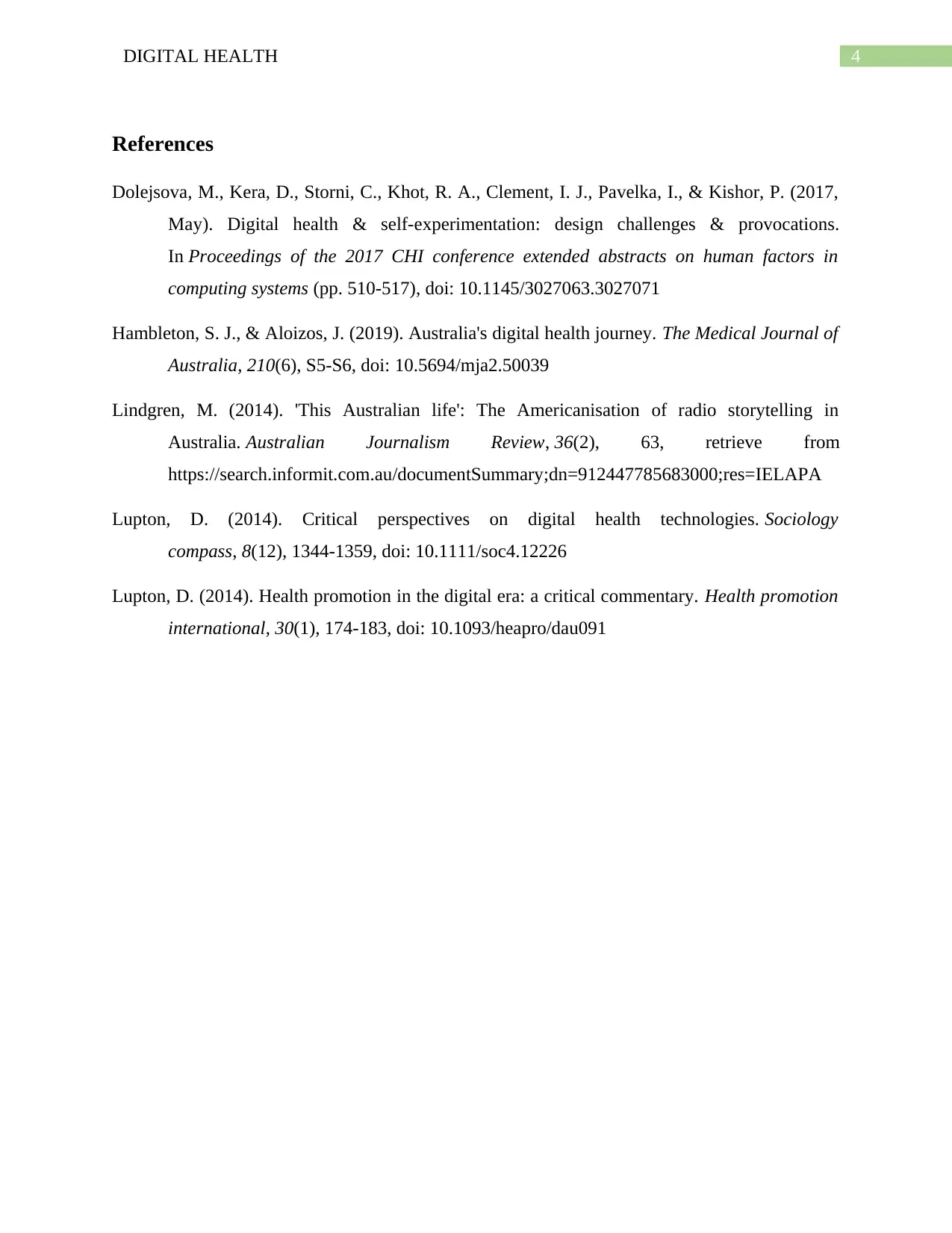
4DIGITAL HEALTH
References
Dolejsova, M., Kera, D., Storni, C., Khot, R. A., Clement, I. J., Pavelka, I., & Kishor, P. (2017,
May). Digital health & self-experimentation: design challenges & provocations.
In Proceedings of the 2017 CHI conference extended abstracts on human factors in
computing systems (pp. 510-517), doi: 10.1145/3027063.3027071
Hambleton, S. J., & Aloizos, J. (2019). Australia's digital health journey. The Medical Journal of
Australia, 210(6), S5-S6, doi: 10.5694/mja2.50039
Lindgren, M. (2014). 'This Australian life': The Americanisation of radio storytelling in
Australia. Australian Journalism Review, 36(2), 63, retrieve from
https://search.informit.com.au/documentSummary;dn=912447785683000;res=IELAPA
Lupton, D. (2014). Critical perspectives on digital health technologies. Sociology
compass, 8(12), 1344-1359, doi: 10.1111/soc4.12226
Lupton, D. (2014). Health promotion in the digital era: a critical commentary. Health promotion
international, 30(1), 174-183, doi: 10.1093/heapro/dau091
References
Dolejsova, M., Kera, D., Storni, C., Khot, R. A., Clement, I. J., Pavelka, I., & Kishor, P. (2017,
May). Digital health & self-experimentation: design challenges & provocations.
In Proceedings of the 2017 CHI conference extended abstracts on human factors in
computing systems (pp. 510-517), doi: 10.1145/3027063.3027071
Hambleton, S. J., & Aloizos, J. (2019). Australia's digital health journey. The Medical Journal of
Australia, 210(6), S5-S6, doi: 10.5694/mja2.50039
Lindgren, M. (2014). 'This Australian life': The Americanisation of radio storytelling in
Australia. Australian Journalism Review, 36(2), 63, retrieve from
https://search.informit.com.au/documentSummary;dn=912447785683000;res=IELAPA
Lupton, D. (2014). Critical perspectives on digital health technologies. Sociology
compass, 8(12), 1344-1359, doi: 10.1111/soc4.12226
Lupton, D. (2014). Health promotion in the digital era: a critical commentary. Health promotion
international, 30(1), 174-183, doi: 10.1093/heapro/dau091
1 out of 5
Related Documents
Your All-in-One AI-Powered Toolkit for Academic Success.
+13062052269
info@desklib.com
Available 24*7 on WhatsApp / Email
![[object Object]](/_next/static/media/star-bottom.7253800d.svg)
Unlock your academic potential
Copyright © 2020–2025 A2Z Services. All Rights Reserved. Developed and managed by ZUCOL.





